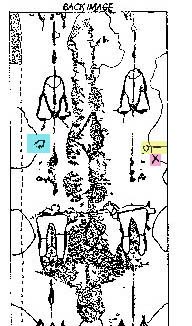✝عیسی مسیح✝
✝Jesus Christ✝✝عیسی مسیح✝
✝Jesus Christ✝Interesting Facts about Jesus
Some groups suggest that Jesus was raised in a spiritual and not a physical body. But Jesus’ actual body was raised from the dead. He tells the disciples:
“Why are you troubled, and why do doubts rise in your minds? Look at my hands and my feet. It is I myself! Touch me and see; a ghost does not have flesh and bones, as you see I have.” (Luke 24:38–39)
To help hammer this truth home to them, Jesus ate in their presence:
And while they still did not believe it because of joy and amazement, he asked them, “Do you have anything here to eat?” They gave him a piece of broiled fish, and he took it and ate it in their presence (Luke 24:42–43).
Jesus got angry. He even turned over tables in the temple. He did not appreciate people that were taking advantage of others in His Father’s house. It might be surprising that Jesus showed His anger, but it is refreshing to know He gets angry over issues such as injustice, just like you and me.
Jesus had more issues with church leaders than the people in the community. During Jesus' ministry, He extended grace and love to ordinary people, even "sinners." And He had some harsh words for the religious leaders of His time. He didn't like the way they treated the people He loved. It shows us that no matter how many followers or how much power and influence we have, it is important to lead others well because He cares more about how we treat others than how well we keep a set of rules.
Jesus had humble beginnings. Born into a carpenter's family, Jesus came from a poor, day-laborer home. This means Jesus would have known what it was like to live in poverty and have hunger and need. Although Jesus is the Son of God, He decided to come to earth as an ordinary guy, just like you and me.
Jesus started His ministry later in life, around the age of 30 years. Some of us might expect Him to have started his ministry when He was born, but He actually went through normal experiences growing up as a baby, small child, teenager, and young adult.
Jesus had an incredible respect for women and even helped a woman who was about to be stoned to death.
Several sources mention Jesus' crucifixion at the hands of Pontius Pilate, the Roman prefect. Christian Gospels say the skies darkened for hours after the crucifixion, which historians viewed either as a miracle or a portent of dark times to come. Using astronomy, later historians have used this mention to pinpoint the death of Christ. Some tie the crucifixion to a one-minute 59-second total solar eclipse that occurred in 29 C.E., whereas others say a second total eclipse, blocking the sun for four minutes and six seconds, in 33 C.E. marked Jesus' death. (C.E. stands for Common Era or Christian Era, and is an alternative name for anno Domini, or A.D.)
Death by crucifixion was one of the goriest ends the Romans meted out, and it was typically reserved for slaves and those seen to be challenging Roman authority.








عیسی ناصری-عیسی مسیح-ישוע-הושע
هزار سال پیش از آنکه عیسی به این زمین بیاید، داود پادشاه نیز آمدن مسیح موعود برای گرد هم آوردن قوم خدا را پیشگویی نمود. « خدای ما میآید، امّا نه در سکوت، بلکه با آتش سوزنده که در پیشاپیش اوست و توفان سهمگین که در اطراف اوست. آسمانها و زمین را به گواهی میطلبد تا بر قوم خود داوری کند. او میفرماید: جمع شوید ای مؤمنانی که با قربانیهای خود با من پیمان بستید » (مزامیر باب ۵۰ آیات ۳ تا ۵).
مسیح از ازل وجود داشته، و همه چیز بهوسیلۀ او هستی یافته، این سؤال پیش میآید که آیا واقعاً لازم بود که پسر خدا جلال آسمان را ترک کند، لباس بشری بپوشد و بهصورت یک انسان ظاهر شود؟
یوحنای رسول به این سؤال جواب میدهد. او در اولین رسالۀ خود پنج دلیل میآورد تا نشان دهد که چرا مسیح بهصورت انسان ظاهر شد. البته قبل از هر چیز، در این رساله مشاهده میکنیم که یوحنا میخواهد روی این موضوع تأکید نماید که مسیح واقعاً بهصورت جسم ظاهر شد. در آن زمان اشخاصی بودند که این حقیقت را رد میکردند و میگفتند که مسیح فقط با روح آشکار شد و نه با جسم. بنابراین، یوحنا در فصل چهارم، آیات ۱ تا ۳ به این موضوع اشاره میکند. نباید فراموش کنیم که مسیحیت مبتنی بر حقایق تاریخی است و اگر کسی میتوانست خلاف این را ثابت کند، مسیحیت از بین میرفت. به همین دلیل، همۀ رسولان به این موضوع بسیار اهمیت میدهند.
برای نمونه پطرس مینویسد: «وقتی ما دربارۀ قدرت خداوند ما عیسی مسیح و آمدن او سخن گفتیم، به افسانههایی که با مهارت ساخته شدهاند متوسل نشدیم، زیرا ما با چشمان خود بزرگی ملکوت او را دیدهایم» (دوم پطرس ۱:۱۶). یوحنا نیز این حقیقت را تأئید میکند و در قسمت اول رسالهاش میفرماید که ما او را شنیدیم و دیدیم و لمس کردیم. بله، همان کلمه که خود خدا بود، واقعاً شکل انسان به خود گرفت و در میان ما ساکن گردید (یوحنا ۱:۱ و ۱۴)
اصطلاح "نجاتدهندۀ عالم" تأئید میکند که پیغام مسیح مخصوص همه، در هر زمان میباشد. به همین جهت، از ابتدای زندگی مسیح بر روی زمین، برای بسیاری آشکار شده بود که او باید "نجاتدهندۀ جهان" باشد. بارها بهخصوص در قسمت اول انجیل لوقا، به این اصطلاح برخورد میکنیم. مثلاً مریم میگوید: «روح من در نجاتدهندۀ من، خدا، شادی میکند» (۱:۴۶)، زکریا میگوید: «از خاندان بندۀ خود داود، رهانندۀ نیرومندی برافراشته است (۱:۶۹)








Jesus Christ-عیسی مسیح-عیسی ناصری
B corresponds to the Aramaic naggara. In fact, Vermes argued
, when the Talmud refers to someone as a “carpenter,”
it might imply a very learned man. This would mean
, then, that the authors of the Gospels would be indicating Joseph
was in fact a learned man, who was not only wise but also
literate in the Torah, regardless of his trade.
ing of τέκτων is sometimes less than totally clear from the context. In some
instances, it seemed best to render it as (a) builder; (b) carpenter; (c) smith;
(d) sculptor; (e) joiner. Four times τέκτων is contrasted with (a) smith; (b)
potter; (c) cobbler. Five times the term αρχιτέκτων is employed, meaning
master builder or architect, and even master!sculptor. In the case of the other
eight instances, it was considered wisest to render τέκτων in such general
terms as builder, craftsman, or artisan.
2. Philo. Now we turn to the Jewish philosopher Philo. Though Jewish,
Philo of Alexandria inhabited a mental world of Hellenistic philosophy and
cultural values, so it is not surprising to find him employing the word τέκτων
in ways similar to the secular Greek writers. He does so three times.
"The τέκτονα ("carpenter) and the painter and the husbandman and the
musician and those who practice other arts (τέχνας). . . the τεκτονικός (carpenter) takes and carves a piece of timber . . . we speak not only of carpenters, but of practicing carpentry (τέκτονι το τεκτονεΐν)" (Sobr. 35.36).
"Some of the arts . . . are practical, but not theoretical, as the arts of the
τεκτονικει, χαλκευτικει (carpenter and coppersmith)" (Leg. 57).
These instances could be rendered as craftsman, but carpenter would
suit the contexts better.
3. Josephus. Turning now to Flavius Josephus, he employs τέκτων four
times in the War, and seven times in the Antiquities. There is an interesting
difference between the two works in regard to the usage of this word. First,
the Antiquities.
Moses, after recompensing with fitting bounties the τέκτονας (craftsmen) who
had executed works so excellent, sacrificed ... (3.204).
They (rulers) will make of them τεχνίτας (craftsmen), makers of armour, of
chariots and of instruments . .. (6.40).
Gifts of cedar wood and skilled men as τέκτονας και οικοδόµους (carpenters and
builders) to construct a palace in Jerusalem (7.66).
You also have many tens of thousands of µυριάδας καΐ τεκτόνων (stone cutters
and carpenters) (7.340).
He had already secured many talents of gold and more of silver, and wood and
a host of τεκτόνων πλήθος και λατόµων (carpenters and stone cutters) as well as
emeralds and precious stones (7.377).
They also began the building of the temple, giving large sums of money to the
λατόµοις και τέκτοσι (stone cutters and carpenters) (11.78).
. . . trained some as οικοδόµους (builders), others as τέκτονας (carpenters)
(15.390).
All of these occurrences of the word have to do with the tabernacle or the
temple or the palace, and plainly Josephus in his reading of the Hebrew text
understands τέκτων in these contexts to refer usually to workers in
ined above—was their devotion to and their knowledge of the Scriptures of
the OT. It is necessary, therefore, to review the Hebrew term that these
Jewish writers (who thought in Aramaic/Hebrew first) translated as τέκτων.
That term is häräs.
5. The Old Testament. In the Hebrew Bible the verb häräs occurs 26
times and means "to cut into, inscribe, to fabricate, out of metal. . . wood,
stone, with an ace. of the material."18
Another lexicon says, "to engrave,
plough, devise. The basic idea is cutting into some material, e.g. engraving
metal or ploughing soil."19
The generality of application is due to the fact
that similar tools were employed to work different materials, most of which
were designed to cut or carve something.
The noun häräs occurs 35 times and means "craftsman; on stone, on
wood; metal worker (smith), armourer; workers of wood and stone; of wood
and metal.,,2° Again, another lexicon gives this rendering: "Engraver, artificer
(a) in metal (b) in wood (c) in stone (d) general."21
NIDOTTE gives "craftsman, artisan," while Cline has "artisan . . . worker in stone . . . in wood . . .
in metal."22
These conclusions are based on the following passages.
First, uncertainties arise in several passages where häräs is set alongside or distinguished from a related term. For example, we find häräs distinguished from (a) builders, masons, stone cutters in 2 Kgs 12:11, 12; 22:6;
(b) smiths in 2 Kgs 24:14, 16; Isa 40:19; 41:7; Jer 24:1; 29:2; 2 Chr 34:11;
(c) masons in 2 Sam 5:11; 1 Chr 14:1; 22:15; 2 Chr 24:12; Ezra 3:7; (d)
woodsman in 1 Chr 22:14 (häräs eben wa'ès)', (e) weavers and designers in
Exod 38:23. While this fluidity can be confusing to the reader, the biblical
authors evidently intend to distinguish between various kinds of craftsmen
and assume that the context sufficiently defines the particular trade or skill
in that specific situation. In temple contexts it appears that workers in
wood were most frequently intended.
Second, there are texts in which the meaning is clearly smiths or metalworkers, often in
the context of fashioning idols: Deut 27:15; 1 Sam 13:19;
Isa 40:19; 44:11-12; 45:16; 54:16; Jer 10:9; Hos 8:6; 13:2; 1 Chr 29:5. Then
in the following contexts, which are concerned with the tabernacle and the
must repudiate the romantic notion that Jesus spent his time sitting on the
hillsides watching the daily activities of his contemporary citizens (often patronized today as mere "peasants"), and taking mental notes of his observations so that he could later use them as sermon illustrations. Rather, Jesus'
employment of stories and metaphors was based on (a) his intimate knowledge of the Scriptures; and (b) his own hard!won experience growing up on
a terraced farm in Nazareth, participating in the cyclical life of the village,
going to work every day, attending the synagogue, and interacting with his
family, clan, neighbors, and strangers.
During most of the twentieth century, the majority of scholarly analysis
of the parables and the teaching of Jesus generally focused on the literary
forms, not the substance of the Gospels material. Under the influence of form
and redaction!critical theories, much effort has been expended in attempting
to separate the "original" teaching of Jesus from the later alleged concerns
of the Church. Not surprisingly, little consensus on this rather subjective
enterprise has been achieved. In what follows we use a different approach.
We are not concerned with the rhetorical and theological uses Jesus made of
the imagery he employed, but with the vocabulary and imagery itself.35
What is indisputable about Jesus' early life is that (a) he interacted on a
daily basis with family, clan, neighbors, and strangers, like everyone else
in a Galilean village; (b) he grew up in the farming village of Nazareth in
Galilee and therefore was involved to an extent daily with its agrarian environment; (c) he
worked with his father at first, then probably with his
family later as a τέκτων, and consequently knew firsthand the occupational
and business experiences of a first!century craftsman. So the scope of the
teaching and vocabulary of Jesus can be allocated to the spheres of (1) agrarian culture;
(2) social interaction; (3) financial affairs; (4) occupation. These
are the areas of Jesus' life which were intrinsic to his existence for thirty
years and from which he consequently drew his vocabulary and descriptive
Several references appear concerning vineyards and wine (Matt 20:1!16;
John 15:1!8; Matt 21:33!44; John 2:1!11). Frequent references to fruit!
bearing trees are also evident (Matt 7:16!20; 12:33 fruit trees; Luke 17:6
mulberry; Matt 24:32!35 pars, fig trees). Jesus refers often to sheep and
shepherding (Matt 9:16; 12:11!12; 18:12!14; 26:31; Mark 14:27; Luke 10:3;
12:32; 14:4!7; 17:7; John 10:1!18; 21:15!17). He also reveals a certain knowledge of fish (Matt 7:10; 12:20) and fishing (Matt 13:47!50; Luke 5:4!11; John
21:6). Jesus was familiar with some of the uses of salt in the economy (Matt
5:13; Mark 9:49!50; Luke 14:34!35).
Not surprisingly Jesus refers to the fauna of Galilee: (a) animals: oxen
(Matt 11:29!30; Luke 13:15); foxes (Matt 8:20 par.; Luke 9:58; 13:32); wolves
(Matt 9:16; Luke 10:3; John 10:12); dogs (Matt 15:26; Luke 16:21); snakes
(Matt 10:16; 23:33); goats (Matt 25:32, 33); calves (Luke 15:23); donkeys
(Luke 13:15); camels (Matt 23:24); gnats and moths (Matt 23:24; 6:19; Luke
12:33); snakes (Luke 10:19); maggots (Mark 9:48). Similarly, there are several references to the bird life of Galilee: (b) birds in general (Matt 8:20;
Matt 13:4; Luke 12:6, 24); eagles (Luke 17:37); vultures (Matt 24:28; Luke
17:37); roosters (Matt 26:34; Luke 22:34) and hens (Luke 13:34); doves (Matt
10:16; Luke 2:24); sparrows (Matt 10:29); and crows (Luke 12:24).
Jesus at times indicates the local flora: grass and flowers (Luke 12:27!28);
thistles (Matt 7:16); thorns (Matt 13:7); grapes (Matt 7:16); wheat (John
12:24). He also indicates his awareness of different soil types (Matt 13:3!8).
Finally, Jesus shows an understanding of the climate, which everyone who
works the land must possess (Matt 5:45; Luke 12:54!56; 17:24).
This is the conversational material that places Jesus in his first!century
Palestinian agrarian context. In reality, there is little surprising about the
knowledge that Jesus displays of his environment. Most of his contemporaries
would have done the same.
In addition to the above, there is a range of domestic and farming terminology in
the mouth of Jesus which is to be expected regardless of his
(παροψίς): Matt 23:25; dish (τρύβλιον): Matt 26:23; Mark 14:20; bucket/basket (µόδιος): Matt 5:15; needle (ραφίς, βελόνη): Matt 19:24; Luke 18:25.
2. Social interaction. We will deal first with Jesus' references to the
home and then to the wider social context.
With regard to the social structure of the home, we discover Jesus referring to the father's care for his children (Matt 7:9!12; Luke 11:11!13). He
reiterates the duty of children to their parents in Matt 15:4!6 pars.; 19:19.
He alludes also to homes with servants (Matt 14:45!51). Jesus furthermore
refers to the Israelite concept of hospitality to strangers (Matt 10:11!14;
Luke 9:2!5) and to friendships (Matt 11:16; 20:13; Luke 14:10; 15:9, 29).
Notable are his earnest concern for widows and his strong denunciations of
those who took advantage of them (Matt 23:14 pars.; Mark 12:42, 43 par.;
Luke 4:25, 26; 7:12; 18:3, 5). Even on the cross he made provision for the
care of his mother (John 19:25!27).
Concerning the dwelling's physical structure, Jesus mentions the private
room of the house (Matt 6:6; Luke 12:3), the guest/dining room of large
homes (Matt 26:3; John 10:16), cellars (Luke 11:33), as well as the roof (Matt
10:27; 14:17). In addition, there is reference in his teaching to the objects
found in small homes such as lamps and bowls which were made of clay, not
wood, and beds which were reed mats (Matt 5:14!16; Mark 4:21; Luke 8:16;
11:33). Activities that he mentions include sweeping (Luke 14:8); cooking
(Luke 12:1; 13:21; in John, Jesus also cooked! John 21:9!13); baking (Matt
13:33 pars.); washing utensils (Luke 11:39); lighting lamps (Matt 5:14!16
pars.); grinding grain (Matt 14:41); sewing (Matt 9:16); and filling wine
bottles (Matt 9:17). All these features of the first!century Palestinian home
were experienced by Jesus in his own home and in those that he visited (or
worked on) before he undertook his public ministry.
Outside of the confines of the home, Jesus gives us considerable information about his social awareness and interaction. Mention is made in his teaching of pregnancy and childbirth (John 16:21) and of orphans (John 14:18).
Matthew tells us that Jesus himself had brothers and sisters (Matt 12:46!
50 pars.). A prominent feature of his teaching is the frequent use of weddings
as a source of instruction (Matt 9:19!20; 22:1!14; 25:1!13; John 2:1!11).
His teaching on marriage and divorce is well known (Matt 5:27!32; 19:3!12),
as are his references to children and their intrinsic value (Matt 18:1!11;
19:13!15). He had obviously observed them at play (Matt 11:16!17; Luke
6:32). He was also familiar with the problem of difficult and rebellious children growing up
(Matt 21:28!32; Luke 15:11!32). The latter parable of "the
prodigal son" raises the matter of family honor, as does Jesus' reference to
social rank in Luke 14:7!15. More than once Jesus makes mention of family
and other social divisions (Matt 12:25!30 pars.). Sometimes he taught that
division is justified by devotion to Jesus that conflicts with existing family
relationships (Matt 10:21!23, 34!42; Mark 10:29!31). In fact, Jesus himself
made a choice between his natural and his new spiritual family (Matt 12:26!
50). Just before his death he made provision for his mother to be received
occupation
references. We will survey them briefly in turn, beginning with the most
familiar sphere of reference
priestly garments, häräs means engravers of precious stones: Exod 28:11;






40 -Interesting Facts about Jesus-2
“Regardless what anyone may personally think or believe about him, Jesus of Nazareth has been the dominant figure in the history of Western culture for almost twenty centuries. If it were possible, with some sort of super-magnet, to pull up out of that history every scrap of metal bearing at least a trace of his name, how much would be left?”
Jesus through the Centuries; His Place in the History of Culture (New Haven: Yale University Press, 1985)
The only in-depth account we have of Jesus comes from the gospels, and John tells us that they only record a fraction of all Jesus did:
“Jesus did many other things as well. If every one of them were written down, I suppose that even the whole world would not have room for the books that would be written” (John 21:25, New International Version).
Even if the gospels don’t offer a complete and unabridged biography of Christ’s earthly life, they’ve given the world enough information to keep poring over His story. And for the 2.3 billion Christians in the world, the gospels tell the remarkable story of God coming to earth to rescue humanity.
Between the well-known stories and parables are little details that illuminate points of interest about Jesus, his disciples, and first-century life in the near east. Here are 40 interesting facts about Jesus’ life
Facts about the birth and childhood of Jesus
The gospels of Luke and Matthew offer the only pictures of Christ’s childhood. Here are some fascinating details they give us.
1. Jesus gets his name from an angel
“The angel went to her and said, ‘Greetings, you who are highly favored! The Lord is with you.’ Mary was greatly troubled at his words and wondered what kind of greeting this might be.
But the angel said to her, ‘Do not be afraid, Mary; you have found favor with God. You will conceive and give birth to a son, and you are to call him Jesus. He will be great and will be called the Son of the Most High. The Lord God will give him the throne of his father David, and he will reign over Jacob’s descendants forever; his kingdom will never end’” (Luke 1:28–33)
2. Jesus is a common first-century name
If God was going to become a human, you’d think that He’d choose a powerful and rare name. That’s just not the case. The name “Jesus” was the John Smith of the first-century. When Christ walked on the earth, He didn’t chase after prominence—and that’s even demonstrated in the name that He chose.







